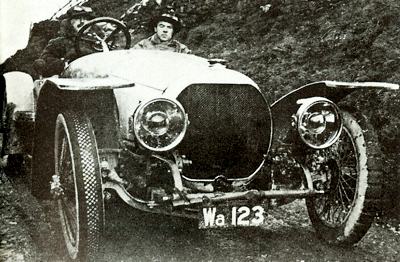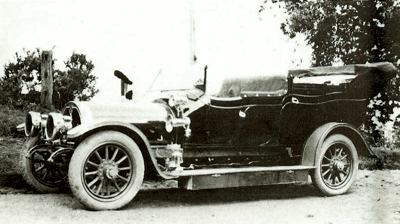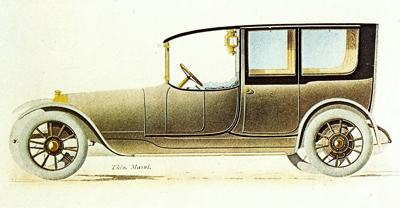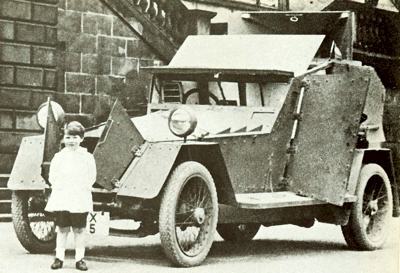The Brotherhood-Cracker
Many vintage car aficionados will tell you that, from the Edwardian era, the Sheffield-Simplex was arguably the best there was. It had its origins in the Brotherhood-Cracker car of 1904, which was constructed by the engineering firm of Peter Brotherhood Limited, who had long been established in the manufacture of high-speed steam engines.
The Brotherhood-Cracker was designed by Percy Richardson, who had formerly been with Daimler, and followed closely on the lines of the contemporary Mercedes, with a pressed-steel chassis, cylinders cast in pairs and double chain drive. A distinctive feature of the marque was the use of the
steering column to carry the horn tube, with the rubber bulb projecting from the centre of the
steering wheel boss.
The first production model was a 12/14hp, and the
prototype covered 23,000 miles on test without any serious mechanical problems before being sold; it was still in service a decade later. The Brotherhood-Cracker works were at 158a Norwood Road, London SE; before long a 20/25 model had become the company's staple product. This had a four-cylinder engine of 3927cc, and boasted an early form of two-pedal control, with a single pedal operating the clutch and brake, and a distinctive sideways pivoting pedal ('avoids fatigue of the ankle muscles' claimed the company) controlling the throttle.
Earl Fitzwilliam
This arrangement, boasted the Brotherhood-Crocker advertising, left 'hands free for steering'. One of the original directors of the company was Earl Fitzwilliam, a wealthy Yorkshire landowner; he took over Brotherhood-Crocker in 1906, and production was switched to a factory at Tinsley, Sheffield. The name of the company was changed to Sheffield-Simplex Motor Works Limited, and the cars became known as 'Sheffield-Simplex', though the Brotherhood title lasted into 1907.
Obviously the company felt that its former name had some merit, and although an entirely new model appeared at the 1907 Olympia Motor Show, they made much of the fact that: 'The Silent Smooth-Running Six-Cylinder Sheffield-Simplex is the redesigned Bratherhood, and embodies many improvements, the result of which is Remarkable Simplicity, Controlled by two Pedals only, made of Special Sheffield Steel.' Priced at UK£750 in chassis form, the new 45 hp Sheffield-Simplex had a 'square' six-cylinder engine, with bore and stroke of 114 mm, giving a swept volume of 6982cc.
The Best Car In The World
Ball-bearings were used throughout the power unit, and the live rear axle had the rear wheels inclined outwards to overcome the effects of road camber. A completely circular
radiator was adopted, and was to remain a distinguishing feature of Sheffield-Simplex cars until the end of production. The inbuilt quality of this car reflected the fact that Earl Fitzwilliam's express wish was that it should be widely considered and esteemed as a claimant for the title of' best car in the world'. But Percy Richardson had something even more remarkable in store: in the summer of 1908 The Autocar tested a new version of the 45hp Sheffield-Simplex, which dispensed with the gearbox. 'Not a departure from, but a remarkable simplification of proved principles,' claimed Sheffield-Simplex. 'Over 150 parts dispensed with, Over 300lbs reduction in weight.'
 A Sheffield-Simplex at Mam Nek in 1914. Pictured in the car are Percy Richardwon (designer of the Sheffield-Simplex) and Sydney Smith.
A Sheffield-Simplex at Mam Nek in 1914. Pictured in the car are Percy Richardwon (designer of the Sheffield-Simplex) and Sydney Smith.
 1908 Sheffield-Simplex 45hp Tourer, which dispensed with the need for a gearbox.
1908 Sheffield-Simplex 45hp Tourer, which dispensed with the need for a gearbox.
 1913 Sheffield-Simplex landaulette with coachwork by Pytchley.
1913 Sheffield-Simplex landaulette with coachwork by Pytchley.
 During World War 1 the Sheffield-Simplex was adapted for the use as an armoured scout car.
During World War 1 the Sheffield-Simplex was adapted for the use as an armoured scout car. |
Despite the claims, the new model did possess an emergency low gear ratio in the back axle, but the idea was that the overall gearing would permit all normal motoring to be done in the one direct ratio, The idea wasn't entirely new, for the monstrous CGV straight eight of 1902 had only one forward speed, but it was the first time it had reached production status. Chassis price of the 'gearbox-less' Sheffield-Simplex was UK£625, compared with the £750 of the same model with conventional transmission, which was used where heavy closed bodies were specified. In fact, the use of just one speed was really only practicable where light open coach-work was fitted, as a delicate path had to be taken between the gears, which were too low for comfortable cruising and too high for hill climbs.
Lands End to John O'Groats
But in Edwardian days, good top-gear performance was highly prized, and there was a transient craze for driving from London to Edinburgh in top gear to prove the 'flexibility' of various luxury cars, notably Rolls-Royce and Napier; the new Sheffield-Simplex was really that craze taken one step further. But one of these cars did manage to travel from Lands End to John O'Groats on its one gear: 'This is the most meritorious and useful trial ever completed, as it is indicative to the average motorist of the true capabilities of the car', enthused Sheffield-Simplex advertising.
Briefly, for the 1910 season, Sheffield-Simplex returned to the manufacture of a four-cylinder model, with the 2883cc 14/20, which in all but its cylinder dimensions seems to have been closely based on the contemporary Renault 14/20; but this was only a temporary aberration, as in 1910 Sheffield-Simplex announced a new 'small' six-cylinder model, the 20/30, of 4324 cc, designed along similar lines to the 45 hp, but equipped with a three-speed gearbox. This model was totally redesigned for 1912, with the cylinders now cast in two blocks of three, and the swept volume increased to 4740cc.
At around the same time of the introduction of this redesigned 30 hp model, the Tinsley works were enlarged to twice their size and new machinery installed. Though the 45hp model, both in gearbox-less and three-speed forms, continued to be listed until 1913, production was now concentrated on the 30hp, which was again redesigned for 1913. The gearbox, which on both 25 hp and 45 hp had been mounted in unit with the back axle, was now moved to the forward end of the torque tube and acquired four speeds, and a double-dropped chassis was standardised; or, as Sheffield-Simplex quaintly put it, 'the frames of these cars have a special step behind the dashboard in order to permit of very low entrances being built in the bodywork.' The ingenious two-pedal control was replaced by a conventional three-pedal layout.
The Tinsley Works
Another feature of the 1913 30 hp was the adoption of a taper bonnet, whose lines were carried on in to the restyled (but still circular) radiator. The company waxed eloquent about the new look: 'The striking presence and luxurious coachwork of the Sheffield-Simplex cars arrest attention like a distinguished face in a crowd.' Once again, only the finest materials were specified for this car: 'There is no better engineering job being turned out anywhere than this 30hp Sheffield-Simplex car. If it were made in an average factory, its cost would be twice as much as it is.
But all the tools at the Tinsley works are of the most modern type, and they turn out a maximum output at a minimum cost. The amount of chrome nickel steel that is used in the chassis is very large.' Thus wrote W. H. Berry, who visited Tinsley in 1914. When he questioned the works manager about the quality of the steel used, he received a somewhat lugubrious reply. , "Costs all the money in the world," said the manager sadly. And then his face brightened up a little and he held up a gear wheel taken from a box that happened to be lying on a bench. "But look at that after 25,000 miles. Hardly a scratch on it."
The work's manager was equally forthright over the car's design philosophy. 'Many designers,' he commented, 'lose sight of the fact that the shortest way between two points is a straight line. There are no unnecessary joints in the framework of a bird, and yet such a structure is about the lightest known consistent with its weight and the work which it is called upon to perform. In other words, there is a reason, and a good one, for every strut and joint. Those are the lines on which the Sheffield had been designed. There has never yet been built a car that did not, at some time or another, have to be dissembled for examination or repair under ordinary circumstances. Granted this fact, surely the designer should make the process of dismantling as easy as possible. What is the use of giving one part a clearance of 1/64 inch if it is possible to allow 1/8 inch?
A Fool Driver
You must remember that every car we sell may be driven by a fool driver. There is no guarding against him, and so we do all in our power to make it as difficult as possible for him to do the chassis serious injury. The back-axle, back wheels, propeller shaft and gearbox can be dismantled inside twenty minutes.' Meticulous quality control was exercised in the construction of the Sheffield-Simplex: all the component parts were separately assembled and tested on their own particular work benches and factory bays under the supervision of men specially skilled in that particular item before being passed over to the chassis assemblers. Any defective part was instantly rejected.
Though the Sheffield-Simplex was solidly built where strength was needed, all unnecessary weight was machined away, especially from components like pistons and gudgeon pins, while heavy castings were supplanted by lighter drop forgings and stampings: and bronze and gunmetal components were stamped out, 'by a comparatively new process'. To eliminate stress points and possible breakages, components were ground after machining, and no steel working part rubbed on another steel working part: in every case, the opposing face was of gun-metal or phosphor bronze, and each part was hardened and ground if necessary.
Percy Richardson and Warwick Wright
Percy Richardson was by now operating from the Company's London Showroom at 20 Conduit Street, London W1, where RoIls-Royce were near neighbours; he had become joint Managing Director, in company with the motor trader Warwick Wright. When Berry returned from Tinsley, Richardson loaned him a Sheffield-Simplex for the weekend: 'The first thing that I did was to start her in top gear. Of course, it was a stupid thing to do. There is no necessity to do things like that - a gearbox is not meant to be purely ornamental - but I had heard that she did the work easily and so tried it. Then she had a thirty mile run through London traffic. A gear change was not necessary. The next thing was to take her over four miles of farm track where she sank almost axle deep in mud. Next she crossed a ditch two feet deep and six feet across.
'I have one fault to find with the equipment. With the exception of the oil indicator there is nothing to inform the driver as to when the engine is stopped. Noise is no guide, for the engine cannot be heard. Of course the self-starter turns her over again, should she be accidentally stopped, but it is disconcerting to let the clutch in and for nothing to happen. When this occurred to me, I was sure that something serious had happened, and had quite an uncomfortable few seconds. A demonstrator to the company told me that he always set the engines to run more quickly than is necessary when he was driving in order to prevent this happening.
'On the following day, I took the car over a series of narrow country lanes, where hair-pin bends are numerous. The ease with which such a long wheelbase car can be handled is delightful ... in her class, and for the purpose for which she is designed, she is supreme. She is a sound engineering job, and marks an epoch in the evolution of the motor car.'
The Ner-a-Car Enclosed Motor Cycle
After the war the 'Improved best car' sank into a gentle oblivion. The car was produced almost unchanged after the Armistice, save for a seemingly retrograde change from the bi-block engine to individually cast cylinders in 1921, and a simultaneous increase in engine capacity to 7777 cc, but there was no place in the vintage years for such a behemoth, and the company spent its declining years building Shefflex trucks and that curious 'car on two wheels', the Ner-a-Car fully enclosed motor cycle to the designs of the American, Carl A. Neracher. Even the Fitzwilliam family abandoned their allegiance to the make. When the doors finally closed, around 1500 cars had been made during the company's history.



